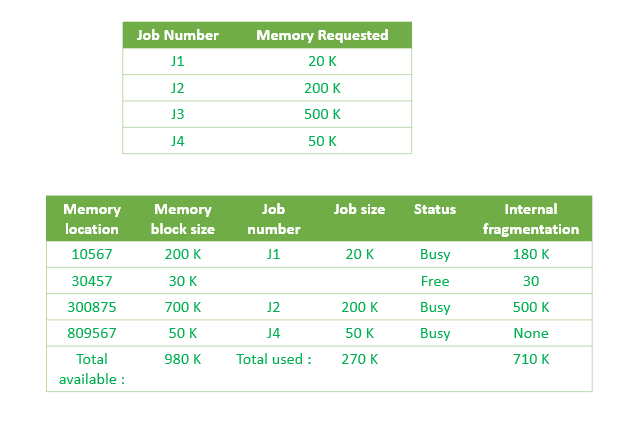First-Fit Allocation in Operating Systems
Last Updated :
31 May, 2023
INTRODUCTION:
First-Fit Allocation is a memory allocation technique used in operating systems to allocate memory to a process. In First-Fit, the operating system searches through the list of free blocks of memory, starting from the beginning of the list, until it finds a block that is large enough to accommodate the memory request from the process. Once a suitable block is found, the operating system splits the block into two parts: the portion that will be allocated to the process, and the remaining free block.
Advantages of First-Fit Allocation include its simplicity and efficiency, as the search for a suitable block of memory can be performed quickly and easily. Additionally, First-Fit can also help to minimize memory fragmentation, as it tends to allocate memory in larger blocks.
Disadvantages of First-Fit Allocation include poor performance in situations where the memory is highly fragmented, as the search for a suitable block of memory can become time-consuming and inefficient. Additionally, First-Fit can also lead to poor memory utilization, as it may allocate larger blocks of memory than are actually needed by a process.
Overall, First-Fit Allocation is a widely used memory allocation technique in operating systems, but its effectiveness may vary depending on the specifics of the system and the workload being executed.
For both fixed and dynamic memory allocation schemes, the operating system must keep list of each memory location noting which are free and which are busy. Then as new jobs come into the system, the free partitions must be allocated. These partitions may be allocated by 4 ways:
1. First-Fit Memory Allocation
2. Best-Fit Memory Allocation
3. Worst-Fit Memory Allocation
4. Next-Fit Memory Allocation
These are Contiguous memory allocation techniques. First-Fit Memory Allocation: This method keeps the free/busy list of jobs organized by memory location, low-ordered to high-ordered memory. In this method, first job claims the first available memory with space more than or equal to it’s size. The operating system doesn’t search for appropriate partition but just allocate the job to the nearest memory partition available with sufficient size. 
As illustrated above, the system assigns J1 the nearest partition in the memory. As a result, there is no partition with sufficient space is available for J3 and it is placed in the waiting list.The processor ignores if the size of partition allocated to the job is very large as compared to the size of job or not. It just allocates the memory. As a result, a lot of memory is wasted and many jobs may not get space in the memory, and would have to wait for another job to complete.
ADVANTAGES OR DISADVANTAGES:
Advantages of First-Fit Allocation in Operating Systems:
- Simple and efficient search algorithm
- Minimizes memory fragmentation
- Fast allocation of memory
Disadvantages of First-Fit Allocation in Operating Systems:
- Poor performance in highly fragmented memory
- May lead to poor memory utilization
- May allocate larger blocks of memory than required.
Like Article
Suggest improvement
Share your thoughts in the comments
Please Login to comment...